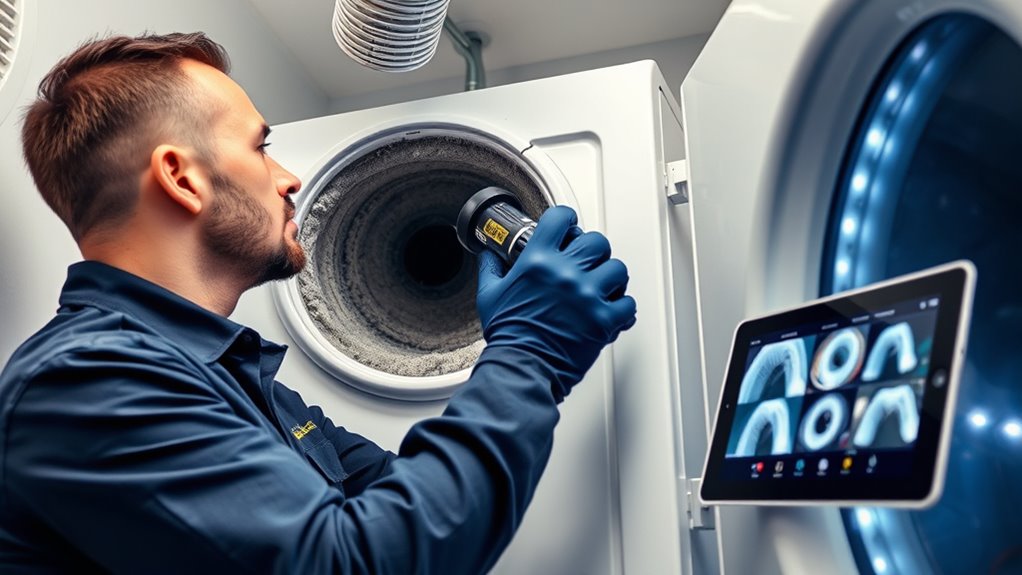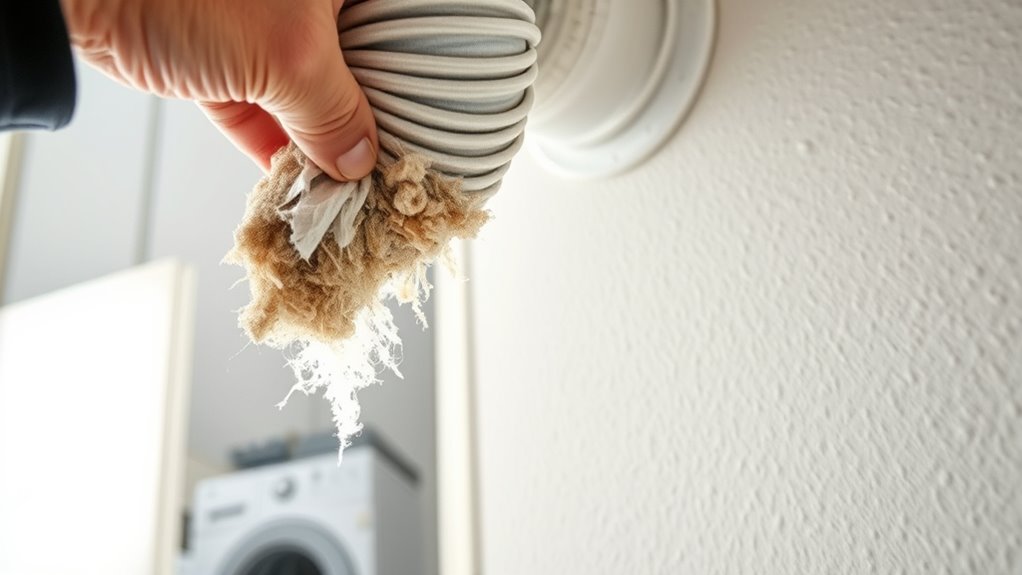To prevent dryer-vent fires, clean your lint trap after every load and inspect your vent system regularly for blockages or damage. Use durable, fire-resistant materials like galvanized steel for your vent ducts, and avoid overly long or kinked hoses. Don’t overload your dryer, and schedule professional inspections at least once a year. Staying vigilant about signs like longer drying times or burning smells helps catch problems early—continue exploring for more tips to keep your home safe.
Key Takeaways
- Regularly clean and inspect the lint trap, vent duct, and hose to prevent lint buildup and blockages.
- Use fire-resistant materials like galvanized steel or aluminum for vent ducts, avoiding plastic or foil options.
- Schedule professional inspections and thorough cleaning of the vent system at least annually.
- Watch for warning signs such as longer drying times, hot clothes, or burning smells, and take immediate action.
- Ensure dryer is properly installed with secure, undamaged fittings and avoid overloading to prevent overheating.
Regularly Clean Your Dryer Vent and Lint Trap

To reduce the risk of a dryer-vent fire, you should regularly clean your dryer vent and lint trap. Lint buildup is highly flammable, so removing it often prevents fires. After each load, empty your lint trap completely, ensuring no lint remains. Every few months, disconnect the dryer and clean the vent duct with a vent brush or vacuum attachment to remove accumulated lint. Check for blockages or kinks in the vent hose, as these restrict airflow and increase fire risk. Keep the vent system clear and functioning efficiently by removing lint that might escape the trap. Regular cleaning not only reduces fire hazards but also helps your dryer operate more efficiently, saving energy and extending its lifespan. Additionally, ensure your dryer vent system complies with safety standards to prevent hazardous conditions.
Inspect and Maintain the Vent System Frequently

You should inspect your dryer vent system regularly to prevent buildup and blockages. Follow a consistent cleaning schedule and look for any obstructions that could hinder airflow. Staying on top of maintenance helps keep your dryer safe and functioning efficiently. Additionally, using inspection and maintenance techniques from reputable sources can further ensure the longevity and safety of your vent system.
Regular Cleaning Schedule
Regularly inspecting and maintaining your dryer vent system is essential for preventing fires. Establish a routine cleaning schedule—at least once a year, or more often if you notice longer drying times or a musty smell. Disconnect the dryer and carefully remove the vent hose, then thoroughly clean out lint and debris using a brush or vacuum attachment. Check both the vent hose and the exterior vent cap for any signs of damage or blockages. Keeping these components free of lint buildup reduces the risk of fire caused by overheating. Be diligent about this routine, especially during peak laundry seasons. Consistent maintenance aligns with recommended safety practices to ensure your dryer operates safely and efficiently, helping prevent dangerous lint fires before they start.
Check for Obstructions
Inspecting your dryer vent system for obstructions is a key step in maintaining safety and efficiency. Over time, lint, debris, or even small animals can block airflow, increasing fire risk and reducing drying performance. Regular checks help you catch issues early before they become dangerous. When inspecting, look for visible blockages, damage, or disconnected sections. Use a flashlight to peer inside the vent and remove any buildup. Remember, even a small obstruction can cause heat to accumulate and spark a fire. Keep in mind:
- Lint buildup near the vent opening
- Twisted or kinked vent hoses
- Disconnected or loose fittings
- Signs of pests or nests
- Excessive debris inside the vent
Routine inspections are essential for safety and prolongs your dryer’s lifespan. Enhanced natural language processing in modern AI tools can assist in identifying potential issues through smart monitoring systems.
Use Proper Materials When Installing or Replacing Vents

When installing or replacing your dryer vent, make sure to select fire-resistant materials to reduce the risk of ignition. Avoid metal foil ducts, as they can trap lint and are more prone to damage. Always check that the vent fits snugly to prevent leaks and ensure safe airflow. Additionally, using proper materials that resist heat and fire can significantly enhance safety and help prevent dryer-vent fires.
Choose Fire-Resistant Materials
Choosing fire-resistant materials is essential when installing or replacing your dryer vent because it markedly reduces the risk of ignition in case of overheating or lint buildup. Fire-resistant materials can slow or prevent flames from spreading if a fire starts. When selecting materials, opt for metal vent ducts, especially galvanized steel or aluminum, which are less combustible than plastic. Avoid using flexible plastic or foil ducts, as they’re more prone to melting and catching fire. Using quality, fire-resistant materials helps ensure safety and compliance with building codes. Additionally, selecting high-quality, fire-resistant duct materials can further enhance the safety of your dryer vent system.
- Use metal ducts instead of plastic or foil
- Ensure materials are rated fire-resistant
- Regularly inspect for damage or wear
- Avoid using combustible sealants or adhesives
- Choose durable, non-flammable connectors
Avoid Metal Foil Ducts
Although metal foil ducts are commonly used because they’re flexible and easy to install, they pose a significant fire hazard. These ducts are easily damaged, which can cause tears or holes that let lint escape and accumulate. The foil material also lacks the durability needed to withstand high temperatures, increasing the risk of melting or catching fire. Avoid using these ducts entirely when installing or replacing your dryer vent. Instead, opt for rigid metal ducts made of aluminum or galvanized steel. These materials resist heat, are less prone to damage, and promote better airflow. Proper materials help prevent lint buildup and reduce fire risk. Using the right type of vent duct is a simple but essential step toward keeping your home safe from dryer-vent fires. Additionally, vent maintenance is crucial to ensure your dryer operates safely and efficiently over time.
Inspect for Proper Fit
Using the right materials is vital to guarantee your dryer vent fits properly and functions safely. A secure, snug connection prevents lint buildup and reduces fire risk. When inspecting, check that the vent and duct sections fit tightly without gaps or loose fittings. Avoid using materials like plastic or foil ducts that can warp or become damaged over time. Instead, opt for rigid metal ducts, such as galvanized steel or aluminum, which provide a durable and safe connection. Ensure all clamps and connectors are secure and properly installed. Proper fitting reduces airflow resistance, improves dryer efficiency, and minimizes fire hazards. Remember, a well-fitted vent system not only protects your home but also ensures your dryer operates safely and efficiently. Regularly inspecting for proper airflow can help identify potential issues early and prevent hazards.
Avoid Overloading the Dryer to Reduce Strain

Overloading your dryer puts unnecessary strain on its components and increases the risk of fires. When you pack the drum too full, it hampers airflow, causing the dryer to work harder and overheat. This extra stress can damage heating elements and other parts, increasing the chance of a fire. To prevent this, always follow the manufacturer’s load capacity guidelines. Leave enough space for clothes to tumble freely so moisture can evaporate efficiently. Drying overloaded loads also takes longer, which means the appliance runs longer and heats more often. Regularly check your loads and remove excess items. Keeping loads manageable helps your dryer operate smoothly, reduces strain, and minimizes fire risks. Additionally, understanding practical support available for seniors can help ensure safe household environments. Remember, less is more when it comes to safe, effective drying.
Schedule Professional Vent Inspections and Cleaning

Scheduling regular professional vent inspections and cleanings is essential to prevent dryer-vent fires. Over time, lint and debris build up inside the vent, increasing fire risk and reducing dryer efficiency. A professional can thoroughly remove blockages and inspect for damage, ensuring proper airflow and safety. Don’t wait for warning signs—routine maintenance is your best defense. Using specialized tools designed for vent cleaning helps ensure a thorough job and minimizes potential hazards.
Be Aware of Warning Signs and Take Prompt Action

Being attentive to warning signs can prevent a dryer-vent fire from occurring. If your laundry takes longer to dry or your clothes feel unusually hot after a cycle, don’t ignore it. A burning smell or a hot dryer surface are serious red flags. Excess lint buildup, even outside the vent, can also signal a problem. If your dryer repeatedly shuts off or if you notice a whistling sound, these are signs that airflow is blocked. Take immediate action by turning off the dryer, unplugging it, and inspecting the vent for obstructions. If you’re unsure, call a professional to evaluate the system. Acting quickly on these warning signs can help you avoid a dangerous fire and protect your home.
Frequently Asked Questions
How Often Should I Replace My Dryer Vent Hoses?
You should replace your dryer vent hoses every three to five years, depending on usage and hose condition. Regularly inspect for cracks, tears, or signs of wear, and clean out lint buildup to improve airflow. If you notice any damage or reduced efficiency, it’s best to replace the hoses promptly. Doing this helps your dryer work more efficiently and prevents potential hazards like fires or overheating.
Can Using a Dryer Sheet Increase Fire Risk?
Ever wonder if that dryer sheet could spark a fire? Using dryer sheets can increase fire risk because they leave a waxy residue that builds up inside your vent and lint trap. This residue can clog airflow and catch fire more easily. To stay safe, consider switching to natural alternatives or unscented, chemical-free options. Regularly cleaning your vent and lint trap helps prevent dangerous buildup and reduces fire hazards.
What Are the Best Tools for Cleaning the Vent System?
When cleaning your vent system, you should use specialized tools like a vent brush or a dryer vent cleaning kit. These tools have long, flexible rods and brushes designed to reach deep inside the ductwork. You can also use a vacuum with a hose attachment to remove loose lint and debris. Regularly inspecting and maintaining your vent system helps keep it clear, safe, and efficient.
How Do I Identify a Blocked or Damaged Vent?
Did you know that clogged dryer vents cause over 15,000 fires annually? To identify a blocked or damaged vent, listen for longer drying times or excessive heat, which signals airflow issues. Check for visible lint buildup, especially near the vent opening. Look for discolored or warped vent components, and make certain the vent hose is intact without tears or kinks. Regular inspections help keep your dryer running safely and efficiently.
Are There Specific Safety Standards for Vent Materials?
You should know that safety standards for vent materials exist to guarantee safe operation. Look for vents made from fire-resistant, durable materials like metal, which meet standards set by organizations such as UL (Underwriters Laboratories). Avoid plastic or foil vents, as they can be a fire hazard. Always check product labels for certification, and follow manufacturer instructions to ensure your vent complies with safety standards and reduces fire risk.
Conclusion
By staying vigilant and maintaining your dryer vent, you’re the captain steering clear of hidden hazards. Regular cleaning and inspections are your lighthouse, guiding you away from the storm of a potential fire. Don’t let lint build-up become a ticking time bomb—take action now. Think of your dryer vent as the heart of your laundry routine; keep it healthy, and you’ll prevent fires before they start, ensuring safety flows smoothly through your home.









